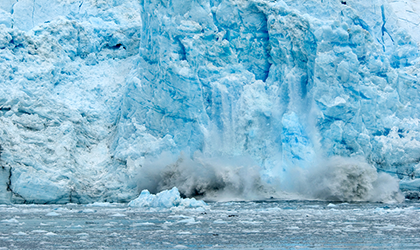
In the coming century, we expect to witness dramatic changes to environments around the world: ice sheet collapse, rainforest dieback and species extinction, to name but a few. One well-known indicator of man-made influence on the climate, the concentration of CO2 in the atmosphere, has risen gradually. But it is wrong to assume that the complex symptoms of climate change will appear gradually. Instead, many environments are expected to reach a new state in a relatively abrupt, unpredictable fashion.
A ball rolling up a hill will experience a complete change in its motion after reaching the peak, from fighting gravity to falling with gravity. At that peak, a tiny nudge can transform the state of the system. Certain parts of the Earth system are expected to reach such a “tipping point” in response to climate change, which will indicate the onset of new behavior of the system.
Indeed, says Dr. Chris Boulton of the University of Exeter, “There is debate about whether or not the loss of Arctic sea ice has already crossed a tipping point. Sea ice extent hit an all-time low in 2007 and, since then, the annual cycle of sea ice extent has had a much larger amplitude. A new all-time minimum was reached in 2012, and the 2016 minimum was tied with 2007 as the second lowest on record.”
The Intergovernmental Panel on Climate Change (IPCC) reported in 2015 “that both warm-water coral reef and Arctic ecosystems are already experiencing irreversible regime shifts”. Yet the panel also acknowledged that “[t]he precise levels of climate change sufficient to trigger tipping points remain uncertain”.
So, how do we detect a tipping point? Dr Valeria Livina from the National Physical Laboratory, who specialises in time-series analysis, describes three parts to the problem of tipping-point analysis. At the pre-tipping stage, Livina says: “Early warning signals provide an indication of dynamical changes in a dynamical system before a tipping occurs. It can be detected using various ‘indicators’ (metrics derived from a time series), which may be based on lag-1 autocorrelations, short-term correlations estimated using Detrended Fluctuation Analysis or Fourier transform, as well as skewness, variance, and others.”
A system reaching the tipping point is confirmed by “detecting the moment of a bifurcation in the time series”, she says. A system which exhibits random behavior can have its indicator described by a probability density function (PDF), and the change in the PDF of the indicator signals the moment of bifurcation. Lastly, post-tipping forecasts use the “extrapolation of the dynamics of the probability density” to continue the time series.
A seminal paper released in 2007 identified several policy-relevant tipping-point scenarios, such as ice-sheet collapse, Arctic sea-ice melt, El-Nino events, monsoons, rainforest size and the Atlantic ocean circulation. Each scenario responds to anthropogenic climate change at different rates, and with a certain amount of lag. In the slow cases, long-term data on the processes is lacking. For example, the strength of ocean circulation is measured with current velocity meters and thermometers, and has been monitored since 2004. However, as Boulton explains, this timescale is insufficient for predicting abrupt changes in ocean circulation. The Atlantic meridional overturning circulation (AMOC), for example, “is a very slowly forced system, with modelling studies suggesting that if it is going to pass a tipping point, it’s unlikely to happen for hundreds of years. So you can begin to see why a 10-year time series would not help much,” he says.
A slow-down in the Gulf Stream, the surface section of Atlantic circulation, was depicted in the film The Day After Tomorrow (with much artistic license http://www.imdb.com/title/tt0319262/?ref_=nv_sr_2) as an almost instantaneous event. Boulton reassures us, however, that “[a] weakening of the AMOC, rather than an abrupt shift and shutdown, is more likely in the short-term”.
Other articles in this series
- Plastic in the ocean: How much is out there, and where does it go?
- Plastic bag charge: Measuring success
About the author
Ronan McAdam is a PhD researcher in physical oceanography at the Department of Physics and the Grantham Institute of Climate Change and the Environment, Imperial College London.




